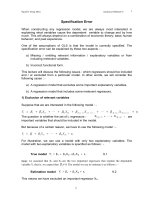Tài liệu Configure NAT docx
Bạn đang xem bản rút gọn của tài liệu. Xem và tải ngay bản đầy đủ của tài liệu tại đây (52.96 KB, 14 trang )
Configuring Network Address Translation DC-693
Configuring Network
Address Translation
Two of the key problems facing the Internet are depletion of IP address space and scaling in routing.
Network Address Translation (NAT) is a feature that allows an organization’s IP network to appear
from the outside to use a different IP address space than what it is actually using. Thus, NAT allows
an organization with nonglobally routable addresses to connect to the Internet by translating those
addresses into a globally routable address space. NAT also allows a more graceful renumbering
strategy for organizations that are changing service providers or voluntarily renumbering into
classless interdomain routing (CIDR) blocks. NAT is also described in RFC 1631.
For a complete description of the NAT commands in this chapter, refer to the “Network Address
Translation Commands” chapter of the Dial Solutions Command Reference. To locate
documentation of other commands that appear in this chapter, use the command reference master
index or search online.
NAT Business Applications
NAT has several applications. Use it for the following purposes:
•
You want to connect to the Internet, but not all your hosts have globally unique IP addresses. NAT
enables private IP internetworks that use nonregistered IP addresses to connect to the Internet.
NAT is configured on the router at the border of a stub domain (referred to as the inside network)
and a public network such as the Internet (referred to as the outside network). NAT translates the
internal local addresses to globally unique IP addresses before sending packets to the outside
network.
•
You must change your internal addresses. Instead of changing them, which can be a considerable
amount of work, you can translate them by using NAT.
•
You want to do basic load sharing of TCP traffic. You can map a single global IP address to many
local IP addresses by using the TCP load distribution feature.
As a solution to the connectivity problem, NAT is practical only when relatively few hosts in a stub
domain communicate outside of the domain at the same time. When this is the case, only a small
subset of the IP addresses in the domain must be translated into globally unique IP addresses when
outside communication is necessary, and these addresses can be reused when no longer in use.
DC-694 Dial Solutions Configuration Guide
Benefits of NAT
Benefits of NAT
A significant advantage of NAT is that it can be configured without requiring changes to hosts or
routers other than those few routers on which NAT will be configured. As discussed previously, NAT
may not be practical if large numbers of hosts in the stub domain communicate outside of the
domain. Furthermore, some applications use embedded IP addresses in such a way that it is
impractical for a NAT device to translate. These applications may not work transparently or at all
through a NAT device. NAT also hides the identity of hosts, which may be an advantage or a
disadvantage.
A router configured with NAT will have at least one interface to the inside and one to the outside. In
a typical environment, NAT is configured at the exit router between a stub domain and backbone.
When a packet is leaving the domain, NAT translates the locally significant source address into a
globally unique address. When a packet is entering the domain, NAT translates the globally unique
destination address into a local address. If more than one exit point exists, each NAT must have the
same translation table. If the software cannot allocate an address because it has run out of addresses,
it drops the packet and sends an ICMP Host Unreachable packet.
A router configured with NAT must not advertise the local networks to the outside. However, routing
information that NAT receives from the outside can be advertised in the stub domain as usual.
NAT Terminology
As mentioned previously, the term inside refers to those networks that are owned by an organization
and that must be translated. Inside this domain, hosts will have address in the one address space,
while on the outside, they will appear to have addresses in a another address space when NAT is
configured. The first address space is referred to as the local address space while the second is
referred to as the global address space.
Similarly, outside refers to those networks to which the stub network connects, and which are
generally not under the organization’s control. As will be described later, hosts in outside networks
can be subject to translation also, and can, thus, have local and global addresses.
To summarize, NAT uses the following definitions:
•
inside local address—The IP address that is assigned to a host on the inside network. The
address is probably not a legitimate IP address assigned by the Network Information Center
(NIC) or service provider.
•
inside global address—A legitimate IP address (assigned by the NIC or service provider) that
represents one or more inside local IP addresses to the outside world.
•
outside local address—The IP address of an outside host as it appears to the inside network. Not
necessarily a legitimate address, it was allocated from an address space routable on the inside.
•
outside global address—The IP address assigned to a host on the outside network by the host’s
owner. The address was allocated from globally routable address or network space.
NAT Configuration Task List
Configuring Network Address Translation DC-695
NAT Configuration Task List
Before configuring any NAT translation, you must know your inside local addresses and inside
global addresses. The following sections discuss how you can use NAT to perform optional tasks:
•
Translate Inside Source Addresses
•
Overload an Inside Global Address
•
Translate Overlapping Addresses
•
Provide TCP Load Distribution
•
Change Translation Timeouts
•
Monitor and Maintain NAT
Translate Inside Source Addresses
Use this feature to translate your own IP addresses into globally unique IP addresses when
communicating outside of your network. You can configure static or dynamic inside source
translation as follows:
•
Static translation establishes a one-to-one mapping between your inside local address and an
inside global address. Static translation is useful when a host on the inside must be accessible by
a fixed address from the outside.
•
Dynamic translation establishes a mapping between an inside local address and a pool of global
addresses.
Figure 130 illustrates a router that is translating a source address inside a network to a source address
outside the network.
Figure 130 NAT Inside Source Translation
1.1.1.2
Host B
9.6.7.3
1.1.1.1
Internet
Inside
Inside
interface
Outside
interface
Outside
1.1.1.2
1.1.1.1
2.2.2.3
2.2.2.2
Inside local
IP address
NAT table
Inside global
IP address
1
3
S4790
SA
2.2.2.2
5
DA
1.1.1.1
SA
1.1.1.1
4
DA
2.2.2.2
2
DC-696 Dial Solutions Configuration Guide
Translate Inside Source Addresses
The following process describes inside source address translation, as shown in Figure 130:
1
The user at Host 1.1.1.1 opens a connection to Host B.
2
The first packet that the router receives from Host 1.1.1.1 causes the router to check its NAT table.
•
If a static translation entry was configured, the router goes to Step 3.
•
If no translation entry exists, the router determines that source address (SA) 1.1.1.1
must be translated dynamically, selects a legal, global address from the dynamic
address pool, and creates a translation entry. This type of entry is called a simple entry.
3
The router replaces the inside local source address of Host 1.1.1.1 with the translation entry’s
global address, and forwards the packet.
4
Host B receives the packet and responds to Host 1.1.1.1 by using the inside global IP destination
address (DA) 2.2.2.2.
5
When the router receives the packet with the inside global IP address, it performs a NAT table
lookup by using the inside global address as a key. It then translates the address to the inside local
address of Host 1.1.1.1 and forwards the packet to Host 1.1.1.1.
6
Host 1.1.1.1 receives the packet and continues the conversation. The router performs Steps 2
through 5 for each packet.
Configure Static Translation
To configure static inside source address translation, perform the following tasks beginning in global
configuration mode:
The previous steps are the minimum you must configure. You could configure multiple inside and
outside interfaces.
Configure Dynamic Translation
To configure dynamic inside source address translation, perform the following tasks beginning in
global configuration mode:
Task Command
Establish static translation between an inside local
address and an inside global address.
ip nat inside source static local-ip global-ip
Specify the inside interface. interface type number
Mark the interface as connected to the inside. ip nat inside
Specify the outside interface. interface type number
Mark the interface as connected to the outside. ip nat outside
Task Command
Define a pool of global addresses to be allocated as
needed.
ip nat pool name start-ip end-ip {netmask netmask |
prefix-length prefix-length}
Define a standard access list permitting those
addresses that are to be translated.
access-list access-list-number permit source
[source-wildcard]
Establish dynamic source translation, specifying
the access list defined in the prior step.
ip nat inside source list access-list-number pool
name
Specify the inside interface. interface type number
Overload an Inside Global Address
Configuring Network Address Translation DC-697
Note
The access list must permit only those addresses that are to be translated. (Remember that
there is an implicit “deny all” at the end of each access-list.) An access list that is too permissive can
lead to unpredictable results.
The following example translates all source addresses passing access list 1 (having a source address
from 192.168.1.0/24) to an address from the pool named net-208. The pool contains addresses from
171.69.233.208 to 171.69.233.233.
ip nat pool net-208 171.69.233.208 171.69.233.233 netmask 255.255.255.240
ip nat inside source list 1 pool net-208
!
interface serial 0
ip address 171.69.232.182 255.255.255.240
ip nat outside
!
interface ethernet 0
ip address 192.168.1.94 255.255.255.0
ip nat inside
!
access-list 1 permit 192.168.1.0 0.0.0.255
Overload an Inside Global Address
You can conserve addresses in the inside global address pool by allowing the router to use one global
address for many local addresses. When this overloading is configured, the router maintains enough
information from higher-level protocols (for example, TCP or UDP port numbers) to translate the
global address back to the correct local address. When multiple local addresses map to one global
address, each the TCP or UDP port numbers of each inside host distinguish between the local
addresses.
Mark the interface as connected to the inside. ip nat inside
Specify the outside interface. interface type number
Mark the interface as connected to the outside. ip nat outside
Task Command









